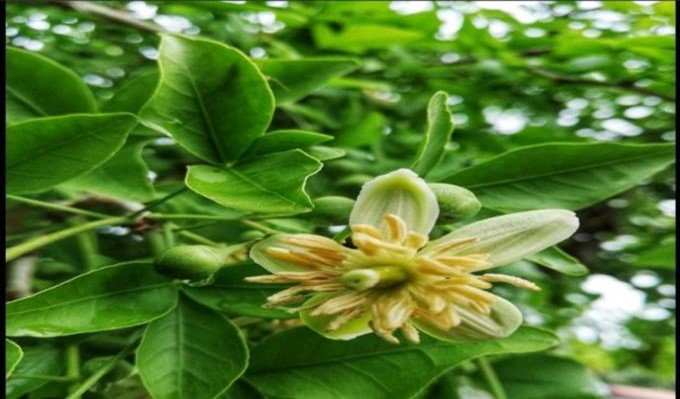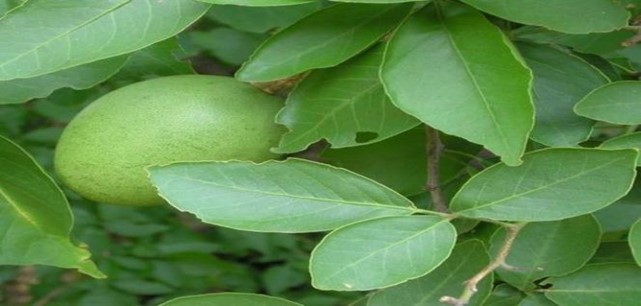Abstract
In recent times, focus on plant research has increased all over the world and a large body of evidence has collected to show immense potential of medicinal plants used in various traditional systems. Over the last few years, rechears have aimed at identifying and validating plant derived substances for the treatment of various diseases. Similarly, it has been already proved that various parts of plants such as Leaf’s, fruits, seeds etc. provide health and nutrition promoting compounds in human diet. The Bael (Aegle Marmelos) (L.) Corr.) is another Indian plant, which has enormous traditional uses against various diseases. The present review aims to compile medicinal values of Aegle Marmelos generated through the research activity using modern scientific approaches and innovative scientific tools.
Keywords
Medicinal, values, Fruit, Leaves, Plants, seeds.
Introduction
Bael contains various phytochemicals like alkaloids, tannins, essential oils, gums, resins, coumarin, polysaccharide that makes it useful in many ailments. Its nutritional aspect is much more significant as compared to other fruit. It also has great importance in the environment. It acts as climatic purifier; it releases greater percentage of oxygen in comparison to other trees. It has numerous crucial therapeutic applications like antifungal, analgesic, anti-inflammatory, antipyretic,hypoglycemic, anti-lipidemic, and immune modulatory, anti-proliferative, wound healing, anti-fertility and insecticidal. The fruits are also used to prepare a large number of by products such as candy, toffee, jam, juice etc. with the help of various post-harvest technologies These technologies helps to reduce the post-harvest losses resulting in increase in the shelf life of Bael products. Thus, it is a good income source for a needy farmer. [1] The aim of this review is to know the phytochemical parameters, traditional uses and innovative applications of Bael fruit.
BIOLOGICAL PROFILE:
SYNONYMS :
The various synonyms of Bael are Hindi (Bel, bael, sripal); Sanskrit (Bilva, sriphal, shivadruma, Shivapala); Telugu (Maredu); Bengali (Bel); Gujrati (Bil); Kannada (Bilpatra, kumbala, malura); Tamil (Kuvalum); Thai (Matum and mapin); Cambodia (Phneou or pnoi); Vietnamese (Baunau); Malayan (Majapahit); French (Oranger du Malabar); Portuguese (Marmelos); Java (Modjo).[2]
BIOLOGICAL SOURCE:
Bael consist of unripe or half ripe fruits of the plant known as Aegle marmelos corr.,
Family: Rutaceae.
ECOLOGY:
Bael is of Indian origin found in various other countries such as Bangladesh, Egypt, Malaysia, Myanmar, Pakistan, Sri Lanka, Thailand. The tree grows wild in dry forests on hills and plains of central and southern India and Burma, Pakistan and Bangladesh, also in mixed deciduous and dry forests[3].
BIOPHYSICAL LIMITS:
Altitude of Bael is 0-1200m; it requires mean annual temperature of 6 to 48º C and mean annual rainfall of 570-2000mm. Further, it requires well-drained soil and also grows well in swampy, alkaline or stony soils with pH 5 to 8.[3,4]
TAXONOMY[2,5]:
Kingdom: Plantae
Order: Sapindales
Family: Rutaceae
Sub family: Aurantioideae
Genus: Aegle
CULTIVATION:
Soil and Climate
Good sandy loam soil, sunny situation, warm humid climate are suitable for cultivation of this plant.
Nursery Raising and Planting
Bael is generally propagated by seeds. Sowing is done in June or July. The development of seedlings is very slow. They require at least a year in the nursery to be fit for transplanting. They should be transplanted in rainy season, the stem is ordinarily 5-7 cm tall with 3-5 leaves, and the taproot, 20-25 cm long. It is also propagated by root cuttings and stem cuttings treating with IBA (4000 ppm) using quick dip method. Seedlings or budded plants are transplanted in the field at a spacing of 10-12 m. Budded plants start bearing fruits at the age of 4-5years, whereas seedling trees require 7-8 years.
Thinning and Weeding
It requires attention during first year when they are well manured and weeded after the rains.
Manures, Fertilizers and Pesticides
The medicinal plants have to be grown without chemical fertilizers and use of pesticides. Organic manures like, Farm Yard Manure (FYM), Vermi-Compost, Green Manure etc. may be used as per requirement of the species. To prevent diseases, bio-pesticides could be prepared (either single or mixture) from Neem (kernel, seeds & leaves), Chitrakmool, Dhatura, Cow's urine etc.
Irrigation:
The field after plantation should be irrigated periodically as and when required weekly or fortnightly.
MACROSCOPIC CHARACTERS:
Aegle marmelos is a slow-growing, medium sized tree, up to 12-15 m tall with short trunk, thick, soft, flaking bark, and spreading with spiny branches. A clear, gummy sap, resembling gum arabic, exudes from wounded branches and hangs down in long strands, becoming gradually solid. It is sweet at first taste and then irritating to the throat.[2,3,6]
Leaves:
The deciduous, alternate leaves, borne singly or in 2's or 3's, are composed of 3 to 5 oval, pointed, shallowly toothed leaflets, 4-10cm long, 2-5cm wide, the terminal one with a long petiole. Mature leaves emit a disagreeable odor when bruised.[4]

Fig.1: Bael Leaves
Flowers:
Flowering occurs in April and May soon after the new leave. Fragrant flowers, in clusters of 4 to 7 along the young branch lets, have 4 recurved, fleshy petals, green outside, yellowish inside, and 50 or more greenish yellow stamens.

Fig.2 : Bael Flower
Fruits:
The fruit, round, pyriform, oval, or oblong, 5-20cm in diameter, may have a thin, hard, woody shell or a more or less soft rind, gray-green until the fruit is fully ripe, when it ripe turns yellowish. It is dotted with aromatic, minute oil glands. Inside, there is a hard central core and 8 to 20 faintly defined triangular segments, with thin, dark-orange walls, filled with aromatic, pale orange, pasty, sweet, resinous, more or less astringent pulp. Fruit ripens in 10 to 11 months from bloom–March to June. Fruits contain 61.5g water, 1.8g protein, 0.39g fat, 1.7g minerals, 31.8g carbohydrates, 55mg carotene, 0.13mg thiamine, 1.19mg riboflavin, 1.1mg niacin, and 8mg per 100g of edible portion vitamin C. Bael fruit is highly nutritive with the richest source of riboflavin

Fig. 3:Bael Fruit
Seeds:
In the pulp 10 to 15 flattened-oblong seeds are present. The seeds are about 1cm long, bearing woolly hairs and each enclosed in a sack of adhesive, transparent mucilage that solidifies on drying.

Fig. 4:Bael Seeds
CHEMICAL CONSTITUENTS OF AEGLE MARMELOS:
Bael gets its medicinal values on basis of the various bioactive compound present in it like alkaloids, coumarins, polysaccharides, essential oils etc. The other nutritional constituents present in Bael fruits are water, sugar, protein, fiber, fat, calcium, phosphorus, potassium, Iron and vitamins (Vit A, Vit B, Vit C and Riboflavin). The major Alkaloids present in Bael are aegelin, aegelinine, fragine, o-methyl halforodinine, oiso pentanyl halfordinol, ethyl cinnamide, ethyl cinnamide. It contains 9% tannin in the pulp of wild fruits and its percentage is less in cultivated type. Tannins are also present in leaves as skimmianine.
The essential oil of the leaves contains d-limonene, 56% a-dphellandrene, cineol, citronellal, citral; 17% pcyrnene, 5% cumin aldehyde. The gum enveloping the seeds is most abundant in wild fruits and especially when they are unripe. The coumarins present in Bael fruit include marmelosin, marmesin, imperatorin, marmin, alloimperatorin, methyl ether xanthotoxol, scoparone, scopoletin, umbeliferone, marmelide and marmenol. Marmelosin a resinous substance is most probably the therapeutically active principle of Bael fruits. Ascorbic acid, sitosterol, crude fibers, ?-amyrin, crude proteins are other minor constituent. The various polysaccharides present in Bael are Galactose, arabinose, uronic acid, Lrhamanose. Carotenoids are principle pigment responsible for imparting pale yellow colour to fruit.[6,7]
EXTRACTION AND ISOLATION OF PLANT MATERIALS:
The leaves (2 kg) dry on the laboratory bench(in shade) for 10 days. The dry sample then mill and ground into powder (1.3 kg). The powdered plant sample (1 kg) pack into a Soxhlet apparatus and extract exhaustively with ethanol for 24 h. The ethanolic extract concentrate using a rotary evaporator at 40°C and then left on the bench to get crude extract (48.5 g). The crude extract partitioned between chloroform and water. A chloroform soluble fraction is obtained. Chloroform fractions subject to column chromatography over silica gel and elute gradually with petroleum ether, petroleum etherchloroform (90:10; 80:20; 70:30) The yield of final solid then re-crystallize from hexane then subject to thin layer chromatography (Chloroform: methanol 7:3) which confirm presence of one band Rf (0.71). The isolated compound coded as AL1 & subjected to qualitative test of alkaloids. The in vitro antibacterial activity of isolated compound (AL1) can be carried out for 24 h culture of selected bacteria. The bacteria Gram-negative organisms: Salmonella typhi, Escherichia coli and two Gram-positive strains comprising Staphylococcus aureus and Bacillus subtilis. Brought Cultures to laboratory conditions by resuscitating the organism in buffered peptone broth and thereafter nutrient agar (peptone 5 g/l and meat extract 3 g/ml) and incubate at 37°C for 24 h.
Antibacterial activity of extract:
Antibacterial activity of Extract can be performed by a filter paper disc diffusion technique. The medium (7 g nutrient agar in 250 ml distilled water, autoclave at 115°C for 15 min.) cool to 50°C. The medium (20 ml) then pour into a sterile Petri dish and allow to solidify, set for 8 h then observe for contamination. The sterility of the medium is tested using autoclave 121°C 15 psi for 15 min. Compound AL1 absolute ethanol and make up to 10 ml with distilled water to give a concentration of 100mg/ml (10% dilution). A colony of each test organism is sub cultured on nutrient broth which will contains peptone (5 g/l and meat extract 3 g/l) and incubate aerobically at 37°C for 8 h. 30 ml of the nutrient broth is used to flood the agar plates. A sterilized Whatman No. 1 filter paper disc soaked in AL1 use to test for the sensitivity or antimicrobial effect of compound isolated from Aegle marmelos. The plates incubate at 37°C for 24 h. After incubation,observe plates for zones of inhibition (in mm diameter). The minimum inhibitory concentration can be determined. Standard drug is tested using incubated agar plate and Streptomycin. The zones of inhibition of Streptomycin on the test organisms are measured and compared with those of isolated compound of the same concentration.
TRADITIONAL USES OF BAEL TREE PARTS FOR MEDICINAL PURPOSE:
The different parts of Bael are used for various therapeutic purposes, such as for treatment of Asthma, Anaemia, Fractures, Healing of Wounds, Swollen Joints, High Blood Pressure, Jaundice, Diarrhoea Healthy Mind and Brain Typhoid Troubles during Pregnancy.[8] Aegle marmelos has been used as a herbal medicine for the management of diabetes mellitus in Ayurvedic, Unani and Siddha systems of medicine in India[9] Bangladesh[10] and Sri-Lanka[11]. The main usage of the parts of this tree is for medicinal purposes. The unripe dried fruit is astringent, digestive, stomachic and used to cure diarrhea and dysentery[12].Sweet drink prepared from the pulp of fruits produce a soothing effect on the patients who have just recovered from bacillary dysentery.[13] The ripe fruit is a good and simple cure for dyspepsia. The pulp of unripe fruit is soaked in gingelly oil for a week and this oil is smeared over the body before bathing. This oil is said to be useful in removing the peculiar burning sensation in the soles. The roots and the bark of the tree are used in the treatment of fever by making a decoction of them. The leaves are made into a poultice and used in the treatment of opthalmia.
The leaf part of the plants have been claimed to be used for the treatment of inflammation, asthma, hypoglycemia, febrifuge, hepatitis and analgesic. The mucilage of the seed is a cementing material.
The wood takes a fine polish and is used in building houses, constructing carts, agricultural implements. A yellow dye is obtained from the rind of the unripe fruits. The dried fruits, after their pulp separated from the rind are used as pill boxes for keeping valuable medicines, sacred ashes and tobacco. In Homeopathic treatments it is largely used for conjunctivitis and styes, rhinitis, coccygodynia, nocturnal seminal emission with amorous dreams, chronic dysentery. Ayurveda prescribes the fruit of the herb for heart, stomach, intestinal tonic, chronic constipation and dysentery; some forms of indigestion, typhoid, debility, cholera, hemorrhoids, intermittent fever, hypochondria, melancholia and for heart palpitation. The unripe fruit is medicinally better than the ripe fruit. Leaf poultice is applied to inflammation; with black pepper for edema, constipation and jaundice.
THERAPEUTIC APPLICATIONS OF AEGLE MARMELOS:
- Diarrhoea and dysentery:
In case of chronic diarrhoea and dysentery without fever, half ripe or unripe fruit acts as a remedy. Half ripe fruit is considered best for the purpose but fully ripe fruits or fruit is still unripe, it is cut, dried and ground into powder. The unripe fruit can also be consumed by baking and then consumption with brown sugar or jaggery. After use of fruit, the amount of blood passed in the fecal matter reduces and the faecal matter gets a more solid form[14,15].
- Antidiabetic:
Aegle marmelos has been used as a herbal medicine for the management of diabetes mellitus in Ayurvedic, Unani and Siddha systems of medicine in India. Bael extract, when administered at a dose of 250mg/kg of body weight, shows better result than glycenamide (antidiabetic drug). This antidiabetic effect may be due to the coumarins present in the fruit. Aqueous extract of bael seeds reduces blood glucose level in case of severe diabetic patients.[1,16,17,18,]
- Antioxidant:
Bael fruit has proven to show antioxidant activity. On administration of Bael fruit extract of 250mg/kg of body weight, shows better results than glibenclamide (36?g/kg). The antioxidant activity may be due to presence of flavonoids, alkaloids, sterols, tannins, phlobatannins and flavonoid glycosides. [17,19,20]
- Antifungal Activity :
Patil R. H ( 2009) reported the antifungal activity of ethanolic extract of the Aegle marmelos leaves including antidiarrhoeal, and antimicrobial, activities[21].Rana B. K. ( 1997) evaluated anti fungal activity of essential oils isolated from the leaves of Bael using spore germination assay. The oil exhibited variable efficacy against different fungal isolates and 100% inhibition of spore germination of all the fungi tested was observed at 500ppm.They proposed that essential oil from bael leaves may interfere with the Ca2+-dipicolonic acid metabolism pathway and possibly inhibit the spore formation [22]Pitre S and Srivastava S.K., ( 1987), demonstrate the antifungal activity of ethanolic root extract against Aspergillus fumiganus and Trichphyton mentagrophytes.[23]
- Anticancer Activity:
Leticia V and Costa L. (2005), evaluated the anticancer potential of folk medicine used in Bangladeshi and used extracts of Aegle marmelos for cytotoxic action using brine shrimp lethality assay; sea urchin eggs assay, and MTT assay using tumor cell lines. The extract of Aegle marmelos was found to exhibited toxicity on all used assays.[24] Similarly, Gagetia G.C. et al ( 2005) reported the anticancer effect of hydroalcoholic extract of bael leaves in the animal model of Ehrlich ascites carcinoma and proposed that induction of apoptosis may be due the presence of skimmianine in extract.[25]
- Radioprotective Activity :
Radioprotective effect of Aegle marmelos extact was studied by Jagetia GC and Venkatesh P (2005)., by exposing to different doses of gamma-radiation in mice and found that oral administration of extract resulted in an increase in radiation tolerance by 1.6 Gy[26].Again, Jagetia GC and coworkers ( 2006), studied effects of plant extract on the peripheral blood and small intestine of Swiss albino mice. They exposed the animals to gamma radiation and data were collected against radiation-induced changes in the peripheral blood, spleen colony forming units, and intestinal mucosa, reported that Aegle marmelos extract significantly reduces the deleterious effect of radiation in intestine and bone marrow of mouse.[27]
- Antispermatogenic Activity:
Pramanik et al, (1999) reported antispermatogenic acitivity of ethanolic extract of Aegle marmelos leaves in rats[28].Again, the same workers, including Bhattacharya D. (2002) presented data of anti motility of rat sperms through In Vitro study[29].Similarly, Sharma R. C et al (2009)[30], studied the effect of ethanol extracts of leaves of A. marmelos for their in vitro effect on sperm motility and was suggested that the extracts had a considerable effect on the motility of sperm. It was also proposed that an increase in concentration of the extracts decreased the motility of sperms.
- Antiulcer Activity:
Goel R..K (1997) reported that oral; administration of pyranocoumarin isolated from the seeds of Aegle marmelos Correa, showed significant protection against pylorus-ligated and aspirin-induced gastric ulcers in rats and cold restraint stress-induced gastric ulcers in rats and guinea pigs.[31] Dhuley J. N; (2007), reported that pretreatment of rats with unripe bael fruit extract produce a significant inhibition of absolute ethanol induced gastric mucosal damage.[32]
- Anti Thyroid Activity:
Panda S, and Kar A. (2006), isolated, Scopoletin (7-hydroxy-6- methoxy coumarin) from Aegle marmelos leaves and evaluate for its potential to regulate hyperthyroidism. It was observed that scopoletin (at 1.00 mg / kg, p.o. for 7 days) to levothyroxine treated animals, decreased serum thyroid hormones level. It was also proved that the scopoletin have superior therapeutic activity than the standard antithyroid drug, propylthiouracil.[33]
- Toxicity Studies:
Total alcoholic, total aqueous, whole aqueous and methanolic extracts were collected from the leaves of A. marmelos by the Veerappan A et al ( 2007) and studied in experimental rats for their toxicity. No histopathological changes were found when extracts of A. marmelos were administered intraperitoneally for 14 days successively at the dose of 50 mg/kg body wt. The collected data demonstrate that the extracts of the leaves of A. marmelos have a high margin of drug safety.[34]
CONCLUSION:
It is quite evident from this review that Aegle marmelos contains a number of phytoconstituents which reveals its uses for various therapeutic purposes. The Plant or its individual parts can be used for treatment of various disorders in human being such as, diabetes, liver toxicity, fungal infection, microbial infection, inflammation, pyrexia and to relieve pain. Still, so much work is required with the Aegle marmelos to investigate the mechanism of actions with other therapeutic activities.
REFERENCES :
- Ravani A, Joshi DC. Processing for value addition of underutilized fruit crops. Trends in Post-Harvest Technology 2014; .2: 15-21.
- Kaur A, Kalia M. Physicochemical Analysis of Bael (Aegle marmelos) Fruit Pulp, Seed and PericarpJ. Chem Sci Review and Letters 2017: 6(22); 1213-1218.
- http://www.kannadigaworld.com
- Wirth EH. Soil and plant analysis. Inter science Publication, New York. 1946: 35(6): 192-192.
- Sharma N, Dubey W. History and Taxonomy of Aegle marmelos:A Review Inter J. Pure Applied Bioscience 2013;1(6): 7-13.
- QadryJ.S. Pharmacognosy, B.S. Prakashan, 12th edition. 2004-05.78-79.
- Charonesiddhi S, Anpurrang.Bioactive compounds and volatilecompounds of Thai Bael fruit (Aegle marmelos L. Correa) as avaluable source for functional food ingredients. Int J of Food Res.2008; 15(3):287-295.
- Saswati Parichha 2004. “Bael (Aegle Marmelos): Nature's Most Natural Medicinal Fruit”, Orissa Review.
- Kar A. Choudhry B. K. and Bandhopadhyay N. G. (2003), “Comparative evaluation of hypoglycemic activity of some Indian medicinal plants in alloxan diabetic rats” J Ethnopharmacol. 84, Page No.105-108.
- Lampronti I, Martello D., Bianchi N., Borgatti M., Lambrtini E.,. Piva R, Jabbars S., Choudhuri M. S., Khan M. T. and Gambari R. (2003), “In Vitro antiproliferative effect on human tumor cell lines of extracts from the bangladesi medicinal plant Aegle marmelos Correa.” Phytomedicine, 10, Page No. 300-308.
- Karunanayake E. H., Welihinda J., Sirimanne S. R. and Sinnadorai G. (1984), “Oral hypoglycemic activity of some medicinal plants of Sri Lanka” J Ethnopharmacol, 11 Page No. 223-231.
- http://www.hort.purdue.edu/newcrop/parmar/01.html/ accessed on 30.11.10,
- http://www.indiamart.com/company/1753104/products.html / Accessed on 30.11.10
- Upadhya S, Shanbhag, KK, Suneetha, G, Naidu BM, Upadhya,SA. Study of hypoglycemic and antioxidant activity of Aegle marmelos in alloxan induced diabetic rats.Int.J. Physio.Pharmacol. 2004; 48: 476 - 480.
- Rakulini R, Kalaichelvi S. A review of Anti-Diarroheal activitiesof Aegle marmelos. J Complement Alter. Med. Res.2019; 7(2): 1-10.
- Maity P, Hansda D, Bandopadhyay U, Mishra DK. Biologicalactivities of crude extracts and chemical constituents of Bael,Aegle marmelos (L.) Corr, In J. Exper. Bio, 2008: 47; 849-861.
- Sabu MC, Kuttan R. Antidiabetic activity of Aegle marmelos andits relationship with its antioxidant properties. Ind. J. Physio. Pharmacol. 2004; 48(1): 81-8.
- Neeraj V, Neeraj B, Bisht V, Johar V. Bael (Aegle marmelos)Extraordinary Species of India: A Review. Int. J. Current Micro Applied Sci. 2017; 6(3):1870-1887.
- Sampath kumar KP, Umadevi M, Bhowmik D, Singh DM, DuttaAS. Recent Trends in Medicinal Uses and Health Benefits ofIndian Traditional Herbs Aegle marmelos. The Pharma Inno. 2012;1(4): 57-65.
- Prakash D, Upadhyay G, Pushpangadan P, Gupta C. Antioxidantand free radical scavenging activities of some fruits. JComplement Integr Med. 2011; 8 (1), 1513-1553.
- Patil R. H., Chaudhary B. & Settipalli S.(2009), “Antifungal and Antiaflatoxigenic activity of Aegle marmelos Linn.”, Pharmacognosy Journol, Volume 1, No. 4
- Rana B. K,.Singh U. P and Taneja V., (1997). “Anti-fungal activity and kinectics of inhibition by essential oil isolated from leaves of Aegle marmelos”, J Ethanopharmacol. 57, Page No.29-34
- Pitre S and Srivastava S.K.(1987), “Pharmacological, microbiological and phytochemical studies on the root of Aegle marmelos”, Fitoterapia, 58, Page No.194
- 24)Latica, V, and Costa, L. (2005)”Evaluation of anticancer potential used in Bangladeshi folk medicine”, J. Ethnopharmacol., 99(1), Page No. 21-38.
- Jagetia GC, Venkatesh P, Baliga MS. (2005); “Aegle marmelos (L.) Correa inhibits the proliferation of transplanted Ehrlich ascites carcinoma in mice”, Biol Pharm Bull 28(1), Page No.58-64.
- Jagetia, G C, and Venkatesh, P. (2005) “Radioprotection by oral administration of Aegle marmelos (L.) Correa in vivo.” J. Environ. Pathol. Toxicol. Oncol., 24, Page No.315-332.
- Jagetia, G C, Venkatesh, P, Archana, P, Krishnanand, B R, and Baliga, M S. (2006), “Effects of Aegle marmelos (L.) Correa on the peripheral blood and small intestine of mice exposed to gamma radiation”, J. Environ. Pathol. Toxicol. Oncol., 25, Page No.611-624
- Sur, T.K, Pandit, S, Pramanik, T. ( 1999); “Antispermatogenic activity of leaves of Aegle marmelos, Corr. in albino rats: A preliminary report”, Biomedicine; 19, Page No.199-202.
- Pramanik, T., Sur, T.K., Pandit, S and Bhattacharyya, D ( 2002); “ Effect of Aegle marmelos leaf on rat sperm motility: An invitro study”, Indian Journal of Pharmacology; 34, Page No.276-277.
- Remya M.,. Sharma R. C., Shoaib H, Asad U. J. R and Singh S., (2009) “In vitro effect of Aegle marmelos on human sperm motility” Journal of Medicinal Plants Research Vol. 3(12), Page No. 1137-1139
- Goel R. K., Maiti R. N, Manickam M.and. Ray A. B. (1997).”Antiulcer activity of naturally occurring pyrano cumarin and isocoumarins and their effect on prostanoid synthesis using human colonic mucosa”, Indian J Exp Biol. 35, Page No. 1080-83.
- Dhuley J. N; (2007), “ Investigation on the gastroprotective and antidiarrhoeal properties of Aegle marmelos unripe fruit extract”, Hindustan Antibiot Bull, 45-46,41.
- Panda S, Kar A; (2006) “Evaluation of the antithyroid, antioxidative and antihyperglycemic activity of scopoletin from Aegle marmelos leaves in hyperthyroid rats”, Phytother Res. Vol- 20(12), Page No.1103-5.
- Veerappan A, Miyazaki S, Kadarkaraisamy M, Ranganathan D (2007) “Acute and subacute toxicity studies of Aegle marmelos Corr., an Indian medicinal plant”. Phytomedicine. 14(2-3), Page No.209-15


 Chitra janardan chavan * 1
Chitra janardan chavan * 1
 Chaitrali G.Markad 1
Chaitrali G.Markad 1
 Deepti R.Indalkar 1
Deepti R.Indalkar 1
 Kishor V. Otari 2
Kishor V. Otari 2




 10.5281/zenodo.11544424
10.5281/zenodo.11544424